The following statements have been disproved by certain studies - you may read these studies right here.
If it is laymen who come up with such statements, it might be contributed to ignorance, but often enough it is physicians who make wrong statements despite being fully aware of their statements being incorrect.
At this point we'd like to make it clear that the acoustic organ and the equilibrium organ is actually one and the same organ, which is the inner ear.
The liquid systems located in the inner ear cause that too much of sound damages the equilibrium organ as well.
It is striking that scholastic medicine declares morbus meniere to be an inner ear disease.
Tinnitus is not declared to be an inner ear disease, but a “symptom” or a “syndrom” (wikipedia) even though the tiny hair of the ear cells damaged by noise are actually verified as a cause.
Source www.dasgesundeohr.de:

Wrong statement: Achievements by laser therapy are actually cases of often occuring spontaneous healings
There are about no cases of spontaneous healing of chronical tinnitus. If that happens, it certainly has to be pursued specifically. Scientific curiosity and responsibility alone should have that effect.
As scholastic medicine denies achievements attributed to laser therapy, patients who achieve improvement or healing due to laser therapy are being monopolized by scholastic medicine and considered cases of spontaneous healing.
We, the patients of LLLT, have to emphasize it explicitly that we are no cases of spontaneous healing as for that we have gone through too detailed experiences of the recovery process.
These patients' experiences are ignored by scholastic medicine. Due to that there are supposed to be no healings of tinnitus attributed to LLLT.
Wrong statement: Achievements by laser therapy are based on placebo effect
When patients hint at the connection between the alteration of their ear noises and the time of their LLLT, this is led back to placebo effect.
M.D. Wilden, the other medics and alternative practioners applying LLLT are attributed the gift to set free specific healing energies in their patients by responding to their patients in a special way.
Activating such powers, however, also lies within the possibilities of every other physician.
Responding to the patient and explaining the intended therapy to him certainly is very important and builds up the patient's basic trust in the treatment that is going to be performed.
However, patients experience their healing process on an acoustic level, and it most often extends over a longer period of time.
The patients have been through a similar but nonetheless individual recovery process that is considered typical of laser therapy.
Without laser therapy there are no such effects, which is also why even a highly empathetic doctor is unable to achieve the same effects as LLLT.
Wrong statement: Upon cutting through the auditory nerve, the tinnitus remained unchanged.
Over and over again in all kinds of fora and even by some physicians the story about the cut-through acoustic nerve is mentioned. The old saying that nothing spreads faster than a rumor is hereby confirmed.
The cutting through of the acoustic nerve and the unchanged tinnitus is not proved with evidence in medical literature.
The statement is often followed by remarks such as "in the sixties" or "many years ago". Evidence of the fact - which would be necessary by a study - never took place.
That cutting through a nerve-line may phantom pain - which in the case of the acoustic nerve would be phantom pains - is explained by MD Wilden in his letter to the "Stern" that you can read on this website (german part) under "Die Medien".
The lines sound as follows:
Amputation pain is not a phenomenon by which you could explain anything related to the ear, but rather a well-understood biological process.
The so-called phantom pain derives from the nerves being cut trough during amputation. The respective nerve-socks.
These are of course traumatized at the place of the amputation and may remain irritated for years and send nerval impulses that are received by the appropriate brain areas.
We know that very well from surgery which treats amputation pains successfully by a so-called pre-amputation in which they make sure that a surgically perfect supply of the nerve-socks is guaranteed.
It seems as if the statement about the unalternated tinnitus is a core piece of the construct upon which the theory of the two places of tinnitus and its migration from the inner ear to diffuse brain regions is built upon.
That theory is used as a scientific basis in medical formation and science.
Thousands of patients whose inner ears have been successfully treated by low level laser therapy provide proof of the incorrectness of that theory, though.
Wrong statement: Tinnitus is produced by the brain.
In the “Apotheken Umschau” issued on September 15th 2009 they aim to suggest patients that tinnitus was a brain disease.
Prof. Gerhard Hesse, leader of the Tinnitus-Klinik Bad Arolsen, provides the following example:
A computer image of the brain shows activities in the acoustic center of a tinnitus-sufferer which are indicated by colourings of the activated brain regions. It is accompanied by the following text:
People with tinnitus perceive noises that noone except themselves is able to hear. Nonetheless, these noises aren't based upon imagination.
The brain does indeed create the impression of an acoustic experience whose sound and velocity can be measured by physicians.
By means of modern methods tinnitus in the acoustic cortex of the brain can be shown in a visual way (see above image). Such research only serves scientific purposes.
The study only had evidentiary value if at the same time it would be verified that no information of the affected inner ear reaches the brain via the acoustic nerve.
It goes without saying that those brain regions of a tinnitus patient are active that eventually need to process the false information coming from the acoustic nerve.
There seem to be certain loopholes in tinnitus research. E.g. scholastic medicine states that tinnitus was caused in the inner ear, the thin hair of the hearing cells were irreperably destroyed and proceeded towards the brain at a later stage. There is a question that remains unanswered by scholastic medicine: What happens to the inner ear when the brain starts to take over the creation of sounds.
There is another discrepancy that derives from the comparison of tinnitus and morbus meniere definition and treatment as they start in the same organ. Morbus meniere is also accompanied by a tinnitus. Due to the irreperability of morbus meniere even here the brain is considered to be responsible. In this case, though, the equilibrium organ in the inner ear is accepted so be the signaler of the error impulse and in severe cases destroyed by antibiotics. That realization of false signals is not applied to the tinnitus.
The thousands of patients successfully treated by low level laser therapy in the inner ear prove the incorrectness of that way of thinking.
Scholastic tinnitus research is thus evidentically on the wrong track and has arrived at a dead-end road.
Wrong statement: Low Level Laser is harmful.
The American Surveillance Office FDA (Food and Drug Administration) jugded low level laser therapy to be a therapy free from side-effects.
More than 30 years of clinical and experimental science have provided evidence that low level laser therapy has no unwanted side-effects.
From time to time, patients treated with low level laser therapy report they perceived the noises in the ear to become louder upon laser treatment.
By irradiating the cochlea with low level laser, a cellular process in the inner ear is started.
That process causes an alteration of the tinnitus which may be perceived as a tinnitus growing more vivid. My personal experience - as well as that of other patients such as Hansi Cross - confirms that.
At the latest after some time it soothes, though, and the noise in the ears settles at a lower level than before. During later stages the effect becomes less.
We three patients of the initiative for the LLLT, who have got much LLLT within the last years, don't feel any defect with our brain.
We don't know any harm from anyone else.
Wrong statement: Low level laser can not reach the cochlea.
This study gives evidence of the cochlea being penetrated by laser on the way to the auditory canal.
![]() Study Tauber etc., 2000
Study Tauber etc., 2000
A study of Michael Zazzio: Administrating Laser light to the inner ear
In November 2006 Michael Zazzio at the Audio Laser-Kliniken in Sweden irradiated a pig's ear from the outside after dividing the skull of the pig.
The tissue sample measured 36 millimeters from the tympanic membrane to the inner incision of the skull.
The LASER light passing through the tissue was photo documented.
Through the results of the study, it is beyond doubt that LASER light in inner ear therapy gets into the inner ear cochlea through the ear canal, via the tympanic membrane, passing the hearing bones and getting through the shell of the cochlea if the LASER probe is placed correctly and in an optimal position, and if the LASER light is administrated in the right direction.
The LASER used in the scientific LASER light penetration study conducted by Michael Zazzio on the 11th of November 2006 was a collimated 35 mW InGaAlP LASER of 650 nm wavelength. LASER light with a wavelength of just above 800 nm has better penetration ability in tissue than the 650 nm LASER, but the 800 nm LASER light is not as visible to the human eye as shorter wavelengths.
 Picture 1. Photo: Michael Zazzio Picture 1. Photo: Michael Zazzio
|  Picture 2. Photo: Michael Zazzio Picture 2. Photo: Michael Zazzio
|  Picture 3. Photo: Michael Zazzio Picture 3. Photo: Michael Zazzio
|
| This picture displays how the LASER light irradiates the ear canal from the outside of the skull bone. The LASER light is aimed towards the inner ear, which is situated a couple of centimeters inside the tissue sample. The black wedge-shaped object in the picture is the LASER probe. | This picture displays the same tissue sample, but here it is taken from the inside of the skull bone, which has been divided halfway into the brain but still contains the hearing organ. The red area in the picture is LASER light irradiating the part where the cochlea of the inner ear is found. | This close-up photography is taken from the same position as picture 2. This enlarged photo clearly displays that the red light ball inside the tissue is LASER drowning the tissue in red LASER light. In this sample it is the tissue in the area where the hearing organ (the cochlea) is found. |
Wrong statement: Studies prove that low level laser does not help.
We deem those studies to be highly deplorable in which low level laser therapy is used at an energy level being too low or for a time period being too short. The conclusion that that low level laser therapy doesn't work for tinnitus is scientifically wrong. Even Aspirine takes a minimum dosage to be able to work.
The exact term of MD Wilden's therapy is not without good reason called: High-dosage Low Level Laser Therapy.
Imagine a medical study that is supposed to find out if sunlight is able to tan skin.
The following experiment set-up is planned: 68 spots of skin among 45 patients are selected.
By randomized principle those patients for the real sun exposure and those for placebo-exposure are determined.
As the treaters who are not supposed to know whether they are applying sunlight or placebo, the experiment is set in such a manner that the treater can't see the light he is applying.
As exposure time it is determined that once a week an exposure takes place for six minutes time.
In the upcoming week there is another exposure of six minutes and in the following two weeks another six minutes each week.
That adds up to 24 minutes in four weeks.
In the end of the experiment, they come to the conclusion that there are no significant differences in exposure to sunlight and placebo light on the patients' skin.
Summing up, the investigator comes up with the conclusion that sunlight is not able to tan human skin.
It goes without mentioning we do know sunlight is able to tan human skin. It was due to a too short time of exposure that the skin was unable to tan.
The applied dosage was just too low and double-blind and randomization have not made the experiment any more realistic.
The study Nakashima contains the same parameters as the example mentioned above.
The following two studies, Nakashima and Mirz, are mentioned as supposed evidence of the ineffectiveness of low level laser therapy.
A 60 mw laser was used once a week, four times in four weeks for six minutes each, a wavelength is not indicated.
A total of 24 minutes of laser in 4 weeks, that is to poor energy to fight against a tinnitus.
![]() Study Nakashima, 2002
Study Nakashima, 2002
Another study uses a weaker laser of 50 mw (wavelength 830 nm) and is applied for ten minutes per treatment. The laser was used 5 days a week and for 3 weeks in total. Because this laser was a pulsed laser in a frequenz from 10 to 1500 hertz there was the real applied energy very small. It's also to poor energy to fight against a tinnitus.
![]() Study Mirz, Aarhus Denmark, 1999
Study Mirz, Aarhus Denmark, 1999
We are thinking that experts such as physicians should start thinking when confronted with these experimental descriptions. Such studies can not provide evidence. Instead of six minutes per week MD Wilden applies 30 minutes five times a week, which adds up to 150 minutes for each ear, which is 25 times as much as in the study. Plus, he uses a much higher dosage. The applied energy in some cases equals even less than one percent of the energy used in a treatment by MD Wilden.
Wrong statement: Suicide in case of tinnitus is not provable
The case of the 29-year old Dietrich Hectors from Belgium, who wrote his last farewell in his "Facebook" profile, before he went out life.
Belgium, 2009:![]() De afscheidsbrief van Dietrich Hectors.
De afscheidsbrief van Dietrich Hectors.
England, North-Wales, 2015:![]() Deganwy man James Ivor Jones jumped to his death after being told there was no cure for his tinnitus.
Deganwy man James Ivor Jones jumped to his death after being told there was no cure for his tinnitus.
Netherlands, 2015:![]() A very sad story: Gaby Olthuis plans her suicide because of her Tinnitus in a video and did it at last.
A very sad story: Gaby Olthuis plans her suicide because of her Tinnitus in a video and did it at last.
In Germany medicine says, there is not proven that Tinnitus is the cause of suicide.
In the Austrian Tinnitus League is honest about suicide:![]() "Unfortunately, even suicide because of tinnitus is reality in Austria."
"Unfortunately, even suicide because of tinnitus is reality in Austria."
My personal experience on the subject of suicide because of tinnitus.
I myself, Manfred can confirm through personal experience, a life with an appropriately loud tinnitus as well as I had him 24 hour, at night a lot louder than a day, sees suicide as the only relief from the constant torment. I also had plans at that time (probably 2004), I had the Dignitas taken in Switzerland in the eye. As a result of LLLT at Dr. Wilden after a few months went better me - I could sleep at night something - so could I refrain from my plan. I sent an email to the Dignitas in which I announced that there is a possible way out for tinnitus sufferers: LLLT. I received no reply, which I accepted. In Germany, this is a taboo subject even today.
 For all of them.
For all of them.